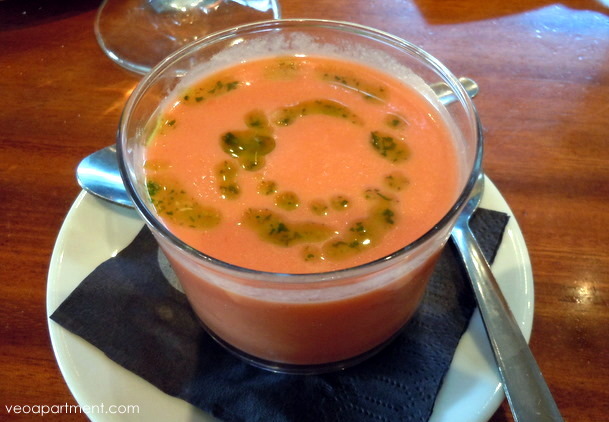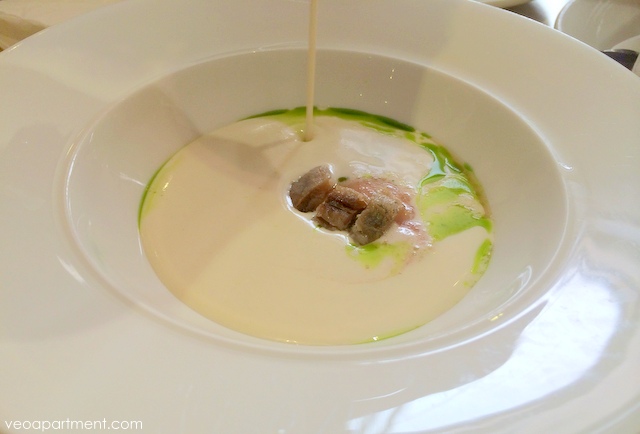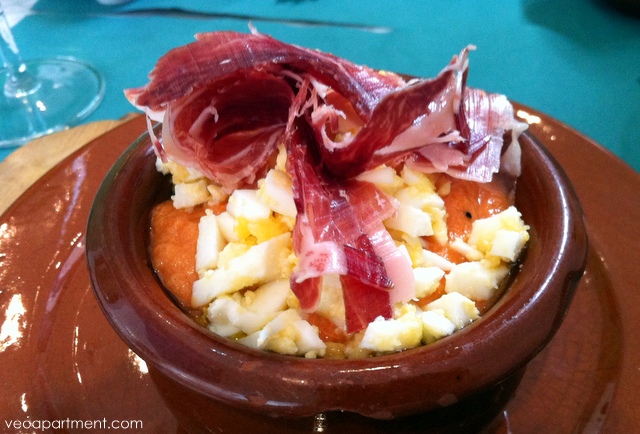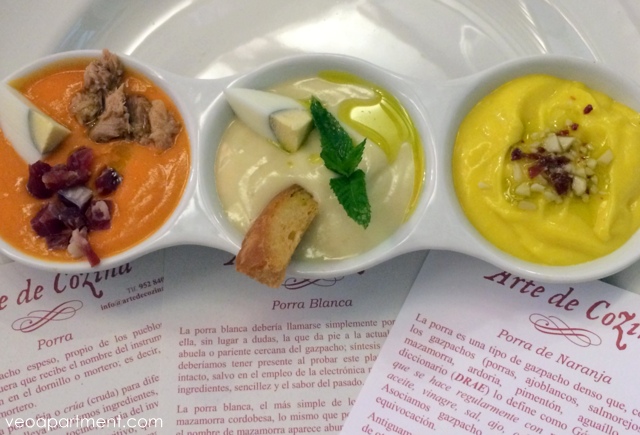Summer is the time when Spanish cooking is all about food that is light and refreshing, and this is when the traditional Spanish cold soups come into their own. The best known of these is gazpacho, which is one of a family of tomato based soups that includes salmorejo and porra, as well as other local variations, but although nowadays tomatoes are often perceived as the most important ingredient, this isn’t really true. The origins of the dish go back to before the discovery of America, and consequently of tomatoes and peppers, both products of the New World. This would leave us with something closer to ajoblanco (cold garlic and almond soup), the other common Spanish cold soup, but without the almonds.
 gazpacho
gazpacho
We can then see that we start in early medieval times with a soup of water, dry bread, olive oil, garlic and vinegar (this indicates a possible Roman origin, as vinegar was important in their cuisine, but not in the Moorish cuisine that followed it), to which were added any leftover vegetables, or less commonly, meat or fish. The basic preparation method was to soak the bread, and to mash it up with the garlic and other vegetables while adding the oil and vinegar to make a paste.
This proto-soup becomes ajoblanco with the addition of peeled, blanched and crushed almonds, which results in a thick, creamy white soup that makes a refreshing change from the tomato varieties. Almonds came to Spain with the Moors, and ajoblanco is generally held to have originated in Malaga and Granada, their last strongholds.
 ajoblanco
ajoblanco
The arrival of tomatoes from the Americas in the early 16th century gave impetus to the evolution of the cold tomato soups that we are familiar with today. Since Sevilla was the port of entry, and the valley of the River Guadalquivir proved perfect for their cultivation (the tomatoes of Los Palacios are renowned for their size and taste, and figure prominently in the displays of the local markets), it’s not surprising that these soups are closely connected with this region of Andalucia, and were, in fact, little known outside this region until the 19th century.
 salmorejo
salmorejo
The differences between the varieties are mostly about the thickness of the soup, and its additional ingredients, and the localities they are associated with. Gazpacho, traditionally associated with Seville ,uses less bread and olive oil, resulting in a thinner mix, and adds more vegetable ingredients, particularly cucumber, but also peppers and onions. Croutons and chopped cucumber and pepper are often added as a garnish.
Salmorejo is thicker and creamier than gazpacho, and is often used as a sauce (one of my favourite tapas is a carpaccio of salt cod topped with salmorejo). A wide range of extra ingredients, such as beetroot, melon and avocados, may be added, and bars specialising in varieties of salmorejo, such as Umami in Cordoba (the official hometown of salmorejo), have started to appear. In Úbeda I even came across a variety for the gluten intolerant that replaced bread with green apples – and very tasty it was too. Usually comes with a garnish of quartered hard-boiled eggs and chopped ham.
 porra
porra
Porra (the word literally means a club, and may refer to the mortar and pestle used to grind up the ingredients) is the thickest of all, with extra breadcrumbs and red or green peppers. Tuna is a popular garnish.
Below are some sample recipes from About.com.
Ajoblanco
Ingredients (quantities for 4 servings)
100 grams blanched, peeled almonds (you can use slivered almonds instead).
3 cloves of garlic (or more to taste)
3-4 slices stale white bread
5 tablespoons extra virgin olive oil
3 tablespoons sherry vinegar
4 cups water
Salt and pepper to taste
Blanch and peel almonds, dry on paper towel and set aside. Peel garlics.
Soak bread in 2 cups of cold water. While bread is soaking put almonds and garlic in blender, and blend on pulse until smooth.
Remove bread from water with slotted spatula and squeeze out excess water. Tear into quarters and add to blender with 1 teaspoon of salt. Blend on pulse, gradually adding olive oil, vinegar and finally the rest of the water. Add more salt, vinegar and oil to taste.
Strain through a sieve into a bowl or other container, pressing as much as possible of the mixture through the sieve. Seal and chill for 3 hours or overnight. Serve in chilled bowls or mugs.
Gazpacho (Andalucian tomato soup)
This is the one you’re most likely to have tried already, a refreshing blend of tomato and cucumber that is Spain’s popular summer standby.
Ingredients (quantities for 4 servings)
1 kg tomatoes, peeled, seeded and coarsely chopped
2 small cucumbers, peeled, seeded and coarsely chopped
2 slices white bread, crust removed
1 small red onion, peeled and coarsely chopped
2 cloves of garlic (or more to taste), minced
1 large green bell pepper
4 tablespoons extra virgin olive oil
2 tablespoons red wine vinegar
salt
1 teaspoon each of finely chopped cucumber and green pepper, and croutons as garnish.
Soak the bread in a few tablespoons of water, remove and squeeze out excess water.
Put bread, tomatoes, cucumbers, onion, pepper and garlic into blender, and blend until smooth. Once all the mixture is blended pour into a large non-metallic bowl. Stir in oil, vinegar and salt. Cover and chill for at least 1 hour. Add garnish when serving if required.
Salmorejo (Cordobes tomato soup)
Thicker and creamier than gazpacho, salmorejo can also be used as a sauce. Personally, I prefer this version, as I’ve never been keen on cucumber, but each to his own.
Ingredients (quantities for 4 servings)
1 kg ripe tomatoes, peeled and seeded
250g white bread, with crust removed, thick sliced
2 cloves garlic
250 ml extra virgin olive oil
60 ml red wine vinegar
salt
2 chilled hard-boiled eggs and 50g serrano ham (or similar), as garnish
Pour about a quarter inch of water into a large glass baking dish, add bread and soak for 30 minutes. Remove, squeeze out excess water, and put in blender. Add tomatoes, garlic and vinegar. Slowly pour in oil while processing, continuing until mixture is smooth. If it’s too thick add a little water. Chill for at least an hour.
Shell and quarter eggs and dice ham. Add as a garnish on serving.
Porra (Antequera tomato soup)
Porra is very similar to salmorejo, but adds red and/or green peppers and more bread to give a thicker mixture. Prepare in the same way as salmorejo.
All of these are, of course, best enjoyed in the land of their origin, with local ingredients. Fortunately this has never been easier, with rented apartments giving you the opportunity both to make your own, and going out to sample what’s on offer in the bars and restaurants.